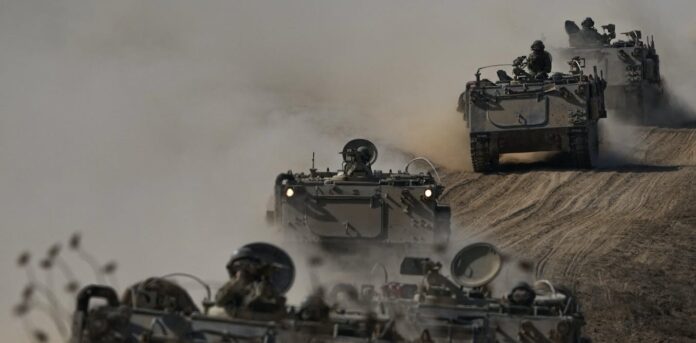Israel seems poised for a massive invasion of Gaza rather than prolonged attrition
By Michael J. Armstrong, Brock University
In the days since the Oct. 7 surprise attack by Hamas, Israel has counted its dead and secured its borders. The country now faces a grim choice.
Will it continue trading air strikes and rocket fire with Hamas militants for a prolonged period? Or will it launch a ground invasion of Gaza that triggers more casualties among Israeli soldiers and Palestinian civilians while risking a two-front war?
The conflict so far already has been bloody. Israel reports 1,300 dead and 3,300 injured, with perhaps 150 more held hostage in Gaza. Israeli officials also say 1,500 Hamas militants who entered Israel have been killed.
Gaza similarly reports 6,600 injured and 1,500 dead, enough to overflow its morgues.
Israel has now secured its border against further Hamas attacks on land. But the rockets keep flying overhead.
Sustained rocketry
Israel has counted 6,000-plus incoming rockets so far. After the first day’s 2,500-rocket barrage, it’s now about 700 per day. Given their estimated stockpiles of between 14,000 and 30,000 rockets, Hamas militants could sustain such rates for many weeks.
The current rocket total has already surpassed the 4,380 reported during the Israel-Gaza conflict in 2021. Similarly, the current 700-rocket daily rate easily beats the 434 average of that 2021 conflict.
Israel’s Iron Dome rocket interceptor systems have consequently been busy. They might even have been overwhelmed on the first day.
The interceptor systems have clearly expended ample ammunition. I estimate they’ve launched roughly 2,300 interceptor missiles so far. Assuming costs of about US$100,000 dollars each, that’s US$230 million spent in six days.
The country’s interceptor stockpile is presumably running low. But Israel will likely receive more interceptor missiles via ammunition resupply flights from the United States that have already begun.
Despite most rockets reportedly being intercepted or landing in open fields, we know some did not. Based on past conflicts, I suspect at least 120 rockets have hit Israeli communities. That implies dozens of civilian deaths, as well as more injuries and much damage.
And each day the barrage continues, Israel suffers perhaps 10 more rocket hits and consumes another US$26 million of interceptors.
The rocketry hurts Israel’s economy too. Businesses lose productivity whenever employees must take shelter. And tourists won’t visit while rockets are falling near airports.
Meanwhile, Israeli warplanes have been pounding Gaza.
Airstrikes and mobilization
They’ve so far dropped 4,000 tonnes of explosives on Gaza.
But my research indicates that airstrikes didn’t slow the rocket fire during previous Gaza-Israel conflicts. Only ground assaults did that.
Warplanes also typically run out of worthwhile targets after about a week. And they’re more likely to kill hostages than to free them.
That’s partly why ceasefires took effect after eight days of fighting in 2012 and 10 days in 2021. And why Israel invaded Gaza on Day 8 of the conflict in 2009 and Day 11 in 2014.
(Oct. 14 will ominously mark Day 8 of this conflict. The clock is ticking.)
Meanwhile, Israel has mobilized 360,000 reservists, giving it half a million soldiers ready for action.
That’s expensive. The military must pay those extra people, while their normal civilian employers must go without them.
Altogether, the current fighting’s direct and indirect expenses could cost Israel at least $7 billion, or 1.5 per cent of its annual economic output. That’s assuming it doesn’t escalate.
A northern front
One place fighting could escalate is Israel’s northern border. In recent days, Hezbollah and Palestinian Islamic jihad militants in Lebanon and Syria have repeatedly fired at Israeli forces. Combatants on each side have been killed.
These attacks were small. But they force Israel to deploy some military units there instead of near Gaza. That includes at least one Iron Dome system.
The attacks also signal that Hezbollah could join the war if Israel invades Gaza. That group has far more soldiers than Hamas does. And its arsenal reportedly contains between 100,000 and 130,000 rockets, including some guided missiles.
So, what happens next?
Decision time
That largely depends on the Israeli government.
Its current situation is painful. The daily rocket salvos harm civilians in Israel, while the airstrikes hurt civilians in Gaza. And the Israeli economy bleeds cash every day the fighting continues.
Meanwhile, Israel’s air force has likely done all it can against Hamas. And the mobilized army is far too large for anything short of a Gaza invasion. The government surely feels pressured to “do something.”
An invasion seems imminent. Israel has told civilians in northern Gaza to flee somehow to the south as Israeli forces move in, presumably to give their soldiers clearer fields of fire.
We might still hope a ceasefire will somehow be brokered. But it appears Israel is about to launch a bloody ground campaign.![]()
Michael J. Armstrong, Associate Professor, Operations Research, Brock University
This article is republished from The Conversation under a Creative Commons license. Read the original article.



